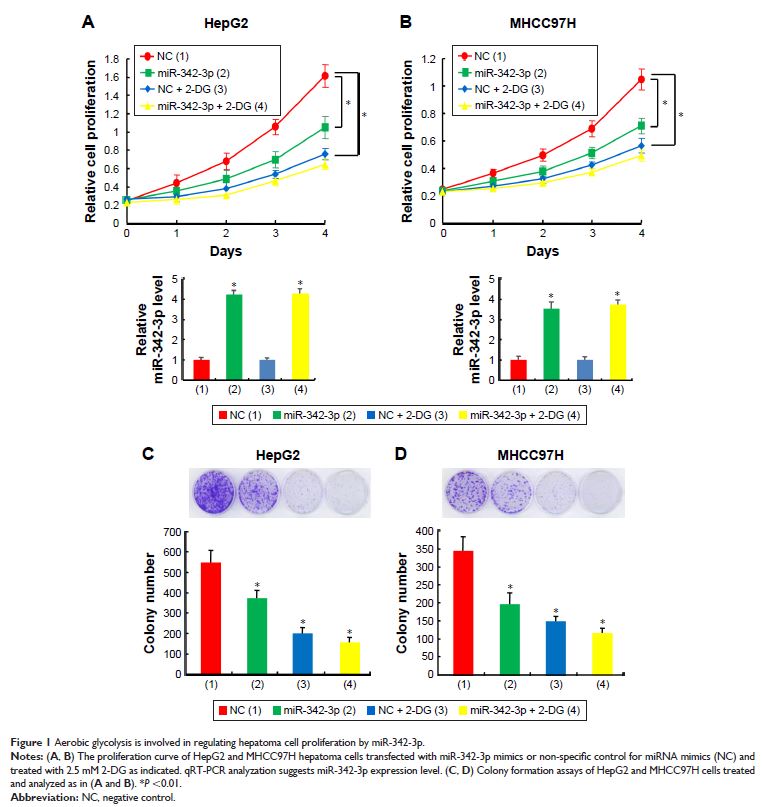108985
论文已发表
注册即可获取德孚的最新动态
IF 收录期刊
- 3.4 Breast Cancer (Dove Med Press)
- 3.2 Clin Epidemiol
- 2.6 Cancer Manag Res
- 2.9 Infect Drug Resist
- 3.7 Clin Interv Aging
- 5.1 Drug Des Dev Ther
- 3.1 Int J Chronic Obstr
- 6.6 Int J Nanomed
- 2.6 Int J Women's Health
- 2.9 Neuropsych Dis Treat
- 2.8 OncoTargets Ther
- 2.0 Patient Prefer Adher
- 2.2 Ther Clin Risk Manag
- 2.5 J Pain Res
- 3.0 Diabet Metab Synd Ob
- 3.2 Psychol Res Behav Ma
- 3.4 Nat Sci Sleep
- 1.8 Pharmgenomics Pers Med
- 2.0 Risk Manag Healthc Policy
- 4.1 J Inflamm Res
- 2.0 Int J Gen Med
- 3.4 J Hepatocell Carcinoma
- 3.0 J Asthma Allergy
- 2.2 Clin Cosmet Investig Dermatol
- 2.4 J Multidiscip Healthc

miR-342-3p 通过抑制 IGF-1R 介导的 Warburg 效应减缓肝细胞癌增殖
Authors Liu W, Kang L, Han J, Wang Y, Shen C, Yan Z, Tai Y, Zhao C
Received 5 January 2018
Accepted for publication 10 February 2018
Published 23 March 2018 Volume 2018:11 Pages 1643—1653
DOI https://doi.org/10.2147/OTT.S161586
Checked for plagiarism Yes
Review by Single-blind
Peer reviewers approved by Dr Colin Mak
Peer reviewer comments 2
Editor who approved publication: Dr Carlos Vigil Gonzales
Background: Insulin-like growth factor-1 receptor (IGF-1R) is a well-studied
oncogenic factor that promotes cell proliferation and energy metabolism and is
overexpressed in numerous cancers including hepatocellular carcinoma (HCC).
Aerobic glycolysis is a hallmark of cancer, and drugs targeting its regulators,
including IGF-1R, are being developed. However, the mechanisms of IGF-1R
inhibition and the physiological significance of the IGF-1R inhibitors in
cancer cells are unclear.
Materials and
methods: Cell proliferation was
evaluated by cell counting Kit-8 and colony formation assay. Western blot and
real-time PCR were accordingly used to detect the relevant proteins, miRNA and
gene expression. Luciferase reporter assays were used to illustrate the
interaction between miR-342-3p and IGF-1R. The effect of miR-342-3p on glycolysis
was determined by glucose uptake, ATP concentration, lactate generation,
extracellular acidification rate and oxygen consumption rate assays. In vivo,
subcutaneous tumor formation assay and PET were performed in nude mice.
Results: In this study, we demonstrate that by directly targeting the 3’-UTR
(3’-untranslated regions) of IGF-1R, microRNA-342-3p (miR-342-3p) suppresses
IGF-1R-mediated PI3K/AKT/GLUT1 signaling pathway both in vitro and in vivo.
Through suppression of IGF-1R, miR-342-3p dampens glycolysis by decreasing
glucose uptake, lactate generation, ATP production, and extracellular
acidification rate (ECAR), and increasing oxygen consumption rate (OCR) in
hepatoma cells. Importantly, glycolysis regulated by miR-342-3p is critical for
its regulating HCC growth both in vitro and in vivo.
Conclusion: Our findings provide clues regarding the role of miR-342-3p as a tumor
suppressor in liver cancer mainly through the inhibition of IGF-1R. Targeting
IGF-1R by miR-342-3p could be a potential therapeutic strategy in liver cancer.
Keywords: miR-342-3p, IGF-1R, liver cancer, glycolysis, metabolism, PET
